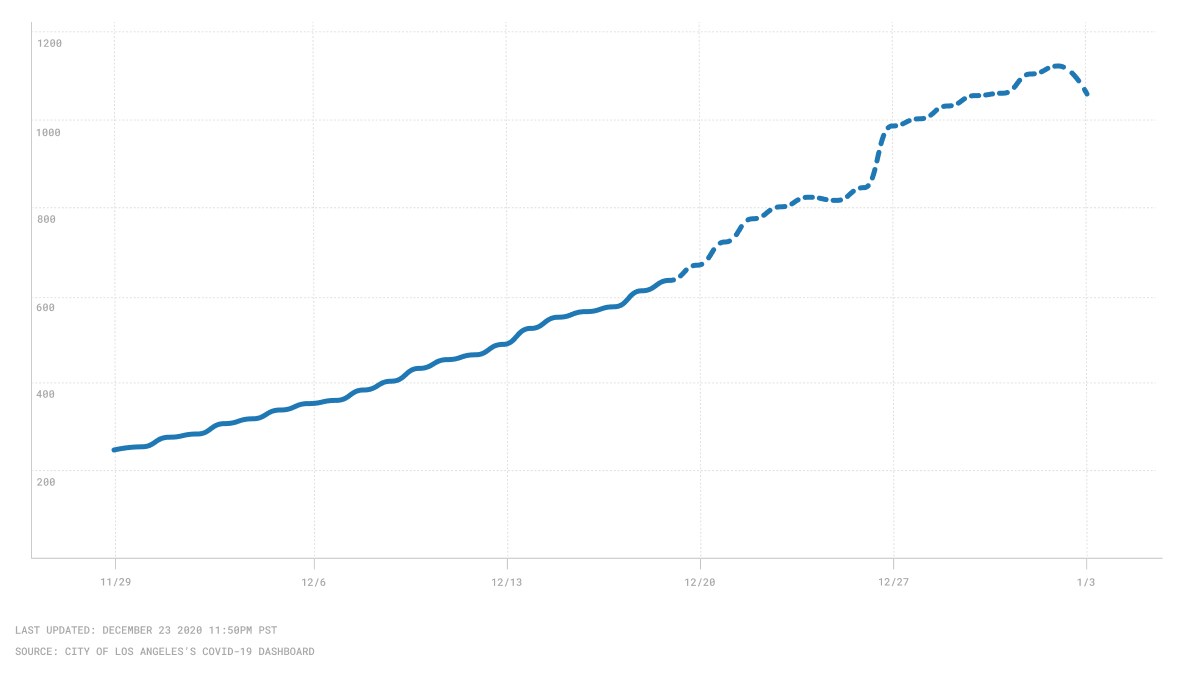What the next two weeks could look like

On Dec. 23, the Los Angeles County Department of Public Health reported 16,525 new COVID-19 infections. In 12 days, that could translate into 1,065 patients who need to be admitted to the hospital.
That would pose serious trouble for a healthcare system that is already on the verge of being overwhelmed, where more than 6,000 county residents are now hospitalized with COVID-19, and where hospitals are beginning to look for makeshift space for expanded ICU units.
Dec. 23 is no outlier: the county has reported more than 11,000 new cases each day since Dec. 15.
The most pressing challenge for public health and elected officials right now – as figures including Gov. Gavin Newsom, Mayor Eric Garcetti and the county’s public health director Dr. Barbara Ferrer have repeatedly stated – is managing the strained supply of hospital beds. Hospitalizations for COVID-19 generally are required about 12 days after the onset of symptoms. Deaths generally occur about four weeks after that, or approximately six weeks after someone contracts the disease. That timeline makes it possible to estimate how the current surge could hit the county’s healthcare system in the coming weeks.
Crosstown examined recent seven-day averages for new county COVID-19 cases, and daily hospitalization figures 12 days later (with data from the City of Los Angeles’ COVID-19 Dashboard). Currently in Los Angeles County, around 7.5% of those who test positive for the virus will need hospital care within that timeline.
Projection of daily COVID-19 hospitalizations in Los Angeles County

The projections are not pretty. And the implications for the county’s hospital system are dire. The county’s Department of Public Health noted on Tuesday that since Nov. 9, daily hospitalizations had already increased by “more than 650%.”
On Tuesday, the county reported that there were 768 total available hospital beds. That is down from around 1,300 a month ago. The total number of ICU beds was 71, down from around 180 a month ago.
A system about to be overwhelmed
Perhaps the most worrying aspect of the current surge in cases is that it could funnel an unprecedented number of sick individuals into the hospital system, and Garcetti has warned that if this occurs, doctors will have to ration care. The 1,065 patients who may need hospital care around Jan. 4 – 12 days after Dec. 23 – would be a steep uptick from current levels.
During each of the last seven days, between 523 to 610 people were admitted to hospitals, according to data used by Garcetti’s office.
Local and state leaders have sought to protect the healthcare system with measures, including a Dec. 6 Regional Stay Home Order for the Southern California region that will remain in effect for at least three weeks. The rising number of cases since then makes it difficult to tell whether the move has had any impact in reducing the spread of COVID-19, particularly as many people yearn to get together over the winter holidays
If there is a glimmer of good news, it is that the hospitalization rate nationally has been coming down, and could continue to do so. According to The Atlantic’s COVID Tracking Project, this is the result of increased testing capacity, which indicates that more people who are asymptomatic or experience mild symptoms are being diagnosed. In addition, more cases are being detected earlier, which allows more time for treatment, leading to fewer hospitalizations. Lastly, more young people – who are less likely to wind up in a hospital – are now being tested.
The other side of the coin is that deaths in Los Angeles County are rising dramatically. On Dec. 23 the Public Health department reported 145 deaths, bringing the total to 9,153.
How we did it: We examined the relationship between the seven-day average of new COVID-19 infections in Los Angeles County based on the Department of Public Health data and the number or new daily hospitalizations in order to project the potential number of new hospitalizations over the next 12 days.
Have questions or want to know more about our data? Write to us at askus@xtown.la.






